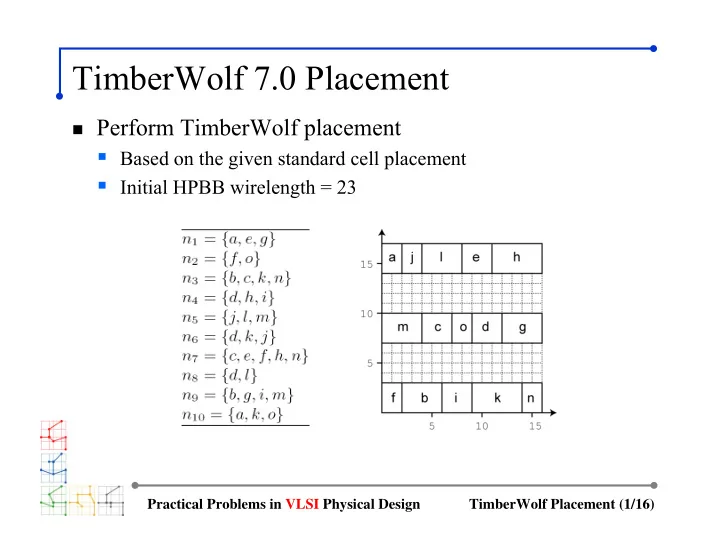

TimberWolf 7.0 Placement � Perform TimberWolf placement � Based on the given standard cell placement � Initial HPBB wirelength = 23 Practical Problems in VLSI Physical Design TimberWolf Placement (1/16)
First Swap � Swap node b and e � We shift node h : on the shorter side of the receiving row � Node b included in nets { n 3 , n 9 }, and e in { n 1 , n 7 } Practical Problems in VLSI Physical Design TimberWolf Placement (2/16)
Computing Δ W � Δ W = wirelength change from swap Practical Problems in VLSI Physical Design TimberWolf Placement (3/16)
Estimating Δ Ws � Δ Ws = wirelength change from shifting � h is shifted and included in n 4 = { d,h,i } and n 7 ={ c,e,f,h,n } � h is on the right boundary of n 4 : gradient ( h )++ � h is not on any boundary of n 7 : no further change on gradient ( h ) Practical Problems in VLSI Physical Design TimberWolf Placement (4/16)
Estimating Δ Ws (cont) Practical Problems in VLSI Physical Design TimberWolf Placement (5/16)
Accuracy of Δ Ws Estimation � How accurate is Δ Ws estimation? � Node h is included in n 4 = { d,h,i } and n 7 ={ c,e,f,h,n } � Real change is also 1: accurate estimation Practical Problems in VLSI Physical Design TimberWolf Placement (6/16)
Estimation Model B � Based on piecewise linear graph � Shifting h causes the wirelength of n 4 to increase by 1 (19 to 20) and no change on n 7 (stay at 28) Practical Problems in VLSI Physical Design TimberWolf Placement (7/16)
Second Swap � Swap node m and o � We shift node d and g : on the shorter side of the receiving row � Node m included in nets { n 5 , n 9 }, and o in { n 2 , n 10 } Practical Problems in VLSI Physical Design TimberWolf Placement (8/16)
Computing Δ W � Δ W = wirelength change from swap Practical Problems in VLSI Physical Design TimberWolf Placement (9/16)
Estimating Δ Ws � Cell d and g are shifted � d is included in n 4 = { d,h,i }, n 6 ={ d,k,j }, and n 8 ={ d,l } � d is on the right boundary of n 6 and n 8 � So, gradient ( d ) = 2 Practical Problems in VLSI Physical Design TimberWolf Placement (10/16)
Estimating Δ Ws (cont) � Cell d and g are shifted � g is included in n 1 = { a,e,g }, and n 9 ={ b,g,i,m } � g is on the right boundary of n 1 and n 9 � So, gradient ( g ) = 2 Practical Problems in VLSI Physical Design TimberWolf Placement (11/16)
Estimating Δ Ws (cont) Practical Problems in VLSI Physical Design TimberWolf Placement (12/16)
Third Swap � Swap node k and m � We shift node c : on the shorter side of the receiving row � Node k included in nets { n 3 , n 6 , n 10 }, and m in { n 5 , n 9 } Practical Problems in VLSI Physical Design TimberWolf Placement (13/16)
Computing Δ W � Δ W = wirelength change from swap Practical Problems in VLSI Physical Design TimberWolf Placement (14/16)
Estimating Δ Ws � Cell c is shifted � c is included in n 3 = { b,c,k,n } and n 7 ={ c,e,f,h,n } � c is on the left boundary of n 3 � So, gradient ( c ) = − 1 Practical Problems in VLSI Physical Design TimberWolf Placement (15/16)
Estimating Δ Ws (cont) Practical Problems in VLSI Physical Design TimberWolf Placement (16/16)
Recommend
More recommend